THEY WENT THATTAWAY
MIGRATIONS OF THE HOUSE OF ISRAEL
________________________________________________________
After being taken captive and relocated below the Black and Caspian Seas, the tribes of the House
of Israel plus tens of thousands of Jews were used by their Assyrian conquerors as a buffer state
to ward off any advances by the Medes. Soon, groups of Israelites started moving out to east, and north.
The main body of people remained in the area for about a hundred years, during which time they fought as
mercenaries for just about everyone. Their unique triangular arrow points were even found in the ruins of
one of the burned gates of Jerusalem; meaning that some of them were in on the conquering of Jerusalem by Nebuchadnezzor! ! Soon after the power of the Assyrians was broken, vast numbers of the Israelites began
several migrations, with the main two groups moving west under the Black Sea, and north through the Dariel
pass of the Caucasas mountains into the steppes of south Russia. A large group also moved east. These
were called Sakka (Saka) and Iskuza by the Medes and Persians. The Japanese name Sakai is but a step
away from Saka. There are many strange customs of unknown origin in Japan that can only be explained
by recognizing that some from the east Jordan tribes of Manasseh, Reuben and Gad, Manasseh being pre-eminant, made their way to that far eastern Island, while their cousins headed west to populate northwest
europe and the far western island of Britain. Some of these migrations were undertaken all the way into the 17th century when, in the final migration, some from the tribe of Manasseh sailed the north Atlantic to Plymouth
to fulfill Isaiah 49:20, which was prophesied to the hegemony of the House of Israel, Ephraim (England).
You see, the crux of the whole LT subject is that the names we want to look for to trace the Israelites
are not the names that historical accounts and archeological finds give those same folks. To more
confuse the issue, large groups of Israelites called themselves by different names. Some of them called themselves the House of Isaac, which is pronounced e-sahk with the emphasis on the last syllable. How
natural for the Persians to call them the Sakka(Sacae in Greek), while the Assyrians called others, the
House of Omri, after the sixth king of Israel. This name sounded like Khumri, and was variously pronounced
Ghumri, Gimri, Gimira, Gammer, all of which turned into the Greek Kimmeroii, our English word
Cimmerians.
The Israelites weren't lost, their name got lost. That fact coupled with the erroneous search
for the Jews' fulfillment of the Old Testament prophesies has held the Lost Tribes teaching in
virtual obscurity these millenia since 500 BC.
At the end of the drawings I've included a list of many of the
names
given to the various groups of Israelites as they made their way to their new homes.
I hope you'll be able to continue in this field of study. You'll probably discover that your own lineage
goes back to those Bible people.
______________________________________
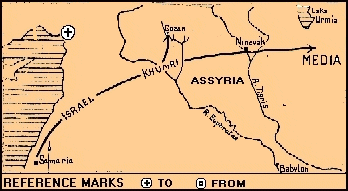
732-700 B C
Israel taken into exile by the Assyrians who called them Khumri, later corrupted to Gimira.

710-590 B C
Israelites, called Gimira by
the Assyrians and Kimmeroii(Cimmerians) by the Greeks, established a reign of terror in Asia Minor.
They finally migrated to Europe, to a place which they called Arsareth (2 Esdras 13:40-44 of the
Apochrypha)
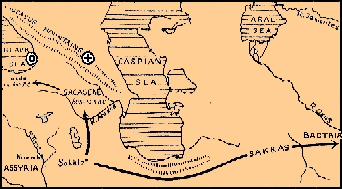
650-600 B C
Israelites in Media became
known as Scythians. Fought as mercenaries; once with Babylon against Jerusalem.
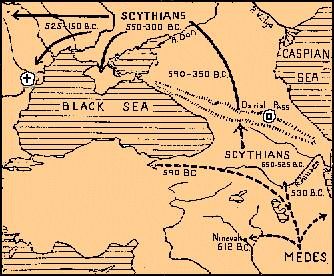
600-500- B C
Following the collapse
of their Assyrian allies, the Scythians were driven north through the Caucasus by the Medes, and they
settled in south Russia.

650-500 B C
Cimmerians in Europe moved
up the Danube and became known as Celts; the English derivative of the Greek Keltoi.
525-300 B C
Others driven out of south Russia by the Scythians moved north-west
between the rivers Oder and Vistula to the Baltic, where they later became known as Cimbri.
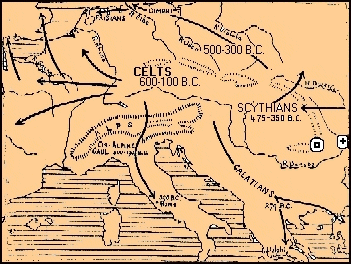
400-100 B C
The Celtic expansion from
central Europe: some attacked Rome in 390 BC and settled for 200 years in northern Italy; others known
as Galatians, after invading Greece in 279 BC, migrated to Asia Minor. Most of them moved west into
France and later to Britain.
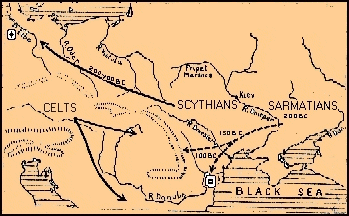
250-100 B C
South Russia was invaded
from the east by the Sarmatians, who drove the Scythians north-west through Poland into Germany.
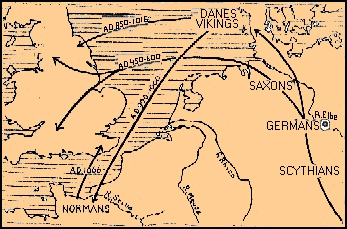
A D 450-1100
The Romans re-named the
Scythians Germans ("genuine") to distinguish from the newly arrived Sarmatians in Scythia. Some of
these came to Britain as Anglo-Saxons, AD 450-600; others, after moving north through Jutland,
became known as Danes and Vikings. Some of these came directly to England,
but others settled for a short time in France and were called Normans.
THE NAME'S THE GAME
This is an incomplete list of names for various groups of Israelites as they migrated.
Khumri, Cimmerians, Sakkas, Sacasene, Sacasune, Schythians, Cimbri, Thraco-Cimmerians, Celt, Galatians, Germans, Saxons, Normans, Danes, Gimira, Kimmeroii, Iskuza, Gauls, Angles, Picts, Iberes, Scots, Basques, Bretons, Goths, Vandals, Lombards, Franks, Burgundians, Ostrogoths, Daci, Belgae, Massagetae and Sarmatians. Had enough?
________________________________________________________
Return to Lost Tribes Subject List.
__________________________________________________
___________________________________________________________________
I love mail.

Come
Home








